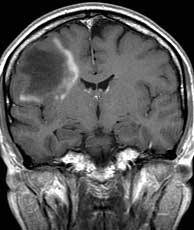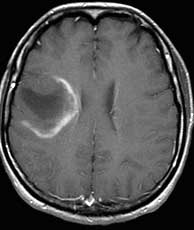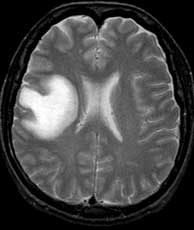 |  |  |
| T1 post-gad | T1 post-gad | T2 |
Diagnosis: Tumefactive multiple sclerosis (Marburg's disease)
Multiple sclerosis is thought to be an autoimmune mediated demyelinating process. It is the most common demyelinating disease , after small vessel ischemia of aging. Women are affected about twice as often as men. The onset is usually between 20 and 40 years age. On imaging, MS typically appears as oval shaped periventricular lesions which are perpendicular to the lateral ventricles. The second most common site of involvement is the corpus callosum. In adults, posterior fossa MS involvement makes up 10% of all cases. This is in contrast to adolescents where the posterior fossa is the most common site of MS involvement. On CT, MS appears as an iso or hypodense lesion which may show enhancement. MS plaques are hypointense on T1 and hyperintense on T2 with variable enhancement. Ovoid periventricular lesions are characteristic. This case is an atypical appearance of MS where the disease presents acutely as a tumefactive lesion with ring enhancement but with little mass effect. This is known as the Marburg form of multiple sclerosis. Patients may present with acute symptoms which may lead to death. This is also known as fulminant monophasic multiple sclerosis. Another atypical appearance of MS is called Balo concentric sclerosis in which the MS lesion is tumefactive with a significant amount of enhancement with multiple concentric layers resembling onion skin in the central aspect. If you have seen tumefactive MS before, the differential is a little easier since it has such a characteristic appearance. The classic findings are a hypointense lesion of the white matter on T1 which is bright on T2 with an advancing edge of enhancement leaving decreased T1 signal in its wake. Mass effect is minimal if any. T2 signal abnormality generally does not extend beyond the rim of enhancement Other things which may come to mind in the differential of a ring enhancing lesion include astrocytoma, metastasis, abscess, or infarction. Lymphoma does not typically produce ring enhancement unless the patient is immunocompromised.
Related Cases Mendez MF, Pogarcar S. Malignant monophasic multiple sclerosis or "Marburg's disease" . Neurology, Jul 1988; 38(7):p1153-5.
Johnson MD, Lavin P, Whetsell WO. Fulminant monophasic multiple sclerosis, Marburg's type. J Neurol Neurosurg Psychiatry, Oct 1990; 53(10):p918-21.








